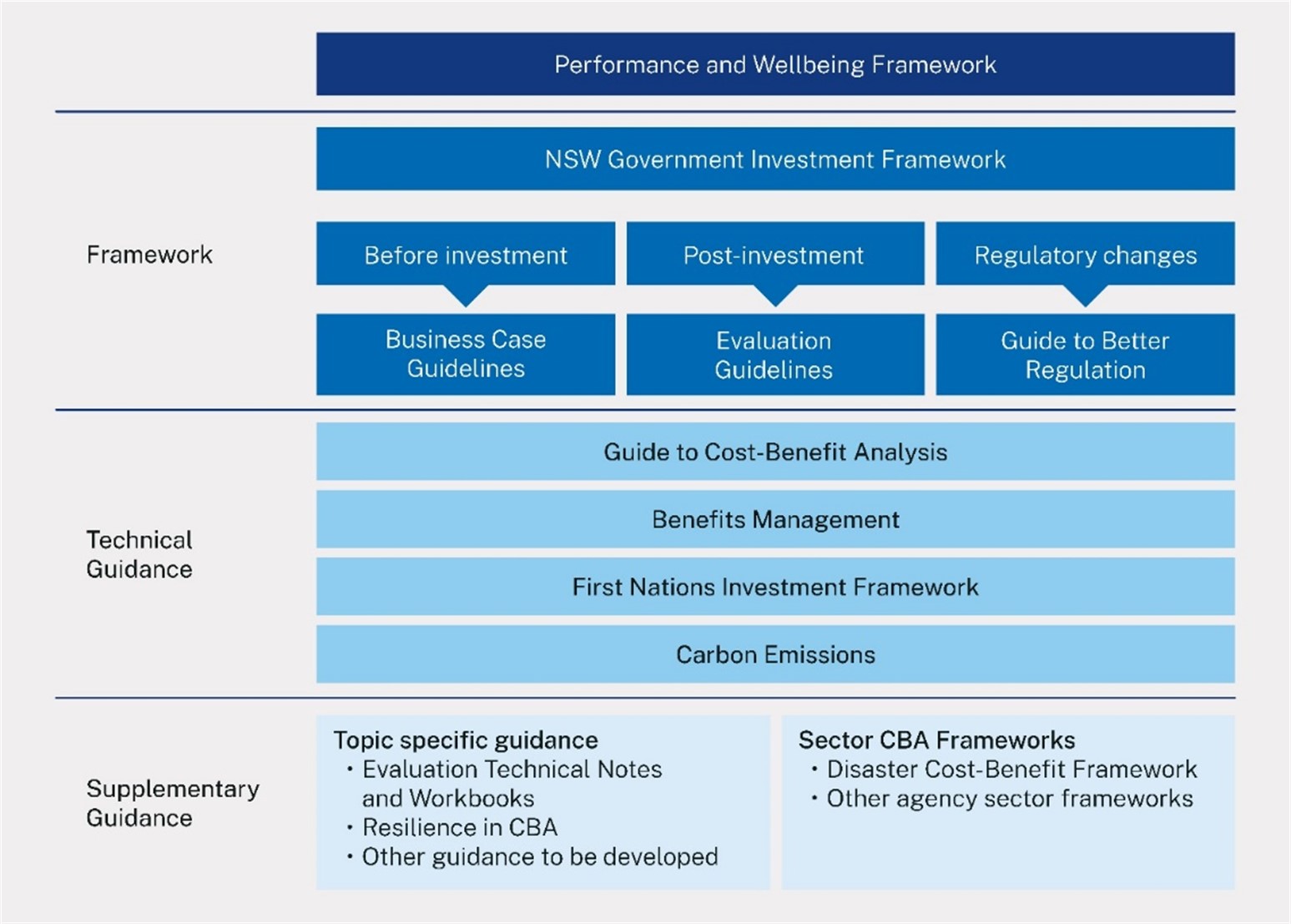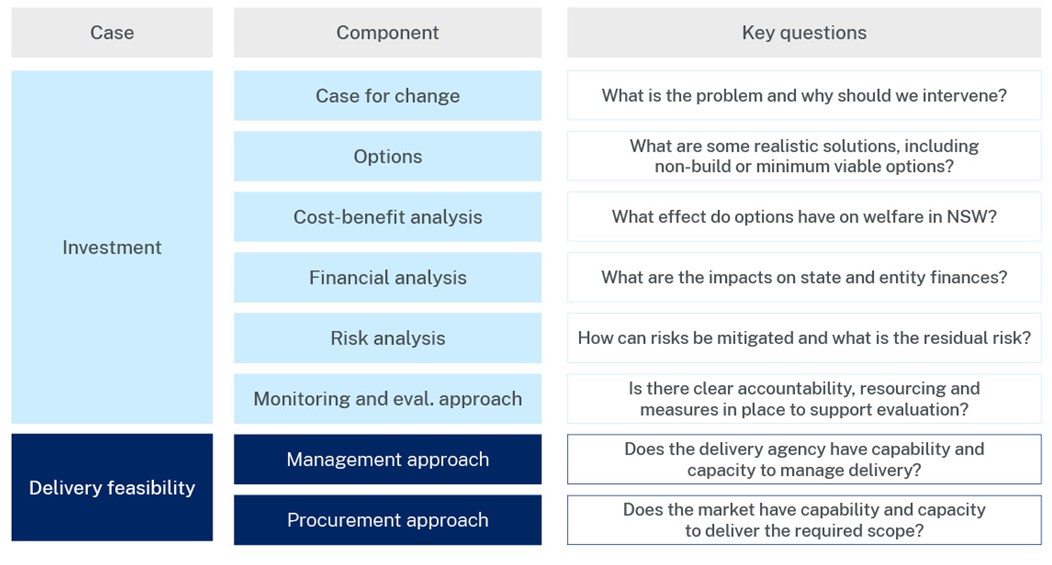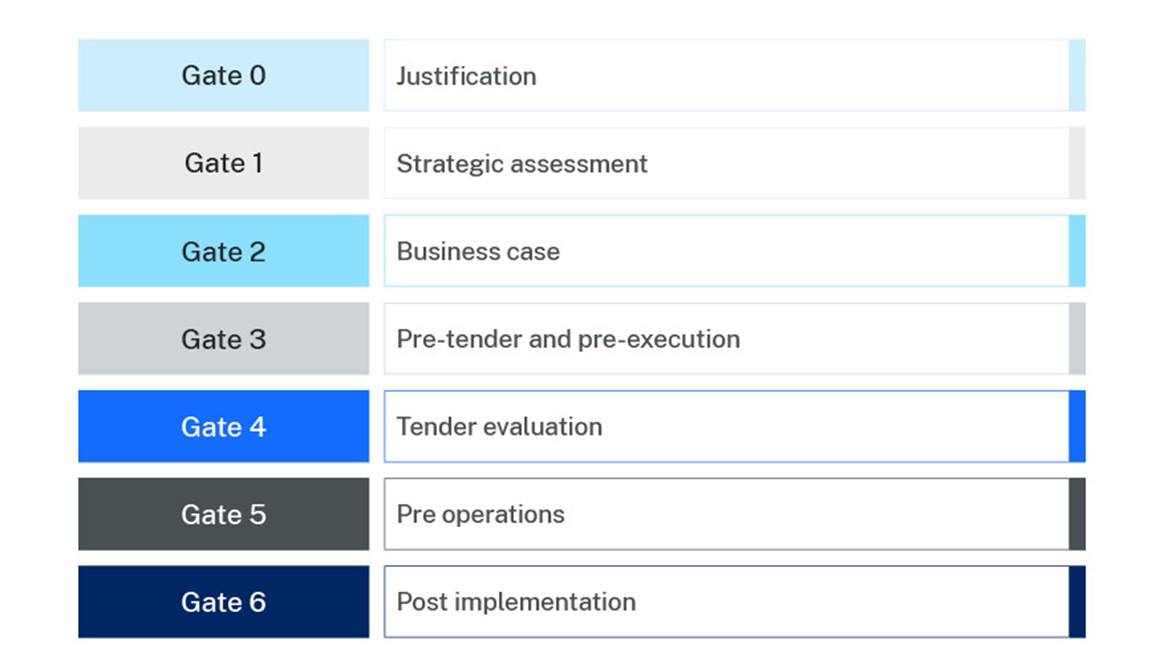On this page
Overview
This section provides detailed information on investment and assurance frameworks in New South Wales.
These frameworks support strong budget and financial management by promoting the effectiveness, efficiency and equity of resource allocation, and ensuring that investments improve the wellbeing of the NSW community.
This section aims to support decision makers and agencies to understand the requirements that support the development of high-quality proposals to achieve these objectives.
NSW Government Investment Framework
Key points
- The NSW Government Investment Framework guides evidence-based decision making by providing a holistic view of appraisal, evaluation and regulatory requirements across the investment lifecycle.
- Business cases provide evidence and detailed information to support government investment decisions. They are not a compliance exercise.
- The NSW Government Business Case Guidelines establish proportionate, risk-based requirements according to proposal type, cost and risk.
- Cost Benefit Analysis (CBA) offers a structure for assessing government initiatives in terms of their capacity to improve the welfare of the community, compared with the required investment.
- Regular evaluations ensure that government initiatives are achieving their intended outcomes and delivering net benefits.
The NSW Government Investment Framework (the Framework) sets out requirements, recommendations and guidance to the sector in support of evidence-based decision making. It applies to projects, programs, changes to regulatory frameworks, and policies.
The Framework presents a holistic, end-to-end view across the investment lifecycle. It provides a structured and consistent approach to developing a comprehensive evidence base to support informed resource allocation decisions and improving New South Wales community wellbeing.
By providing a structured approach to support government resource allocation decisions, the Framework also supports strong financial management and the effective stewardship of public resources in New South Wales.
Agencies are required to adhere to the mandatory evidence requirements set out in the Framework as part of the annual budget process. Figure 1 provides an overview of the suite of policies and guidance, which includes primary guidance documents, technical guidance, and supplementary guidance materials.
The key policy guidance that underpins budget decision-making and will be detailed further below are the:
- TPG24-29: Business Case Guidelines: guidance on the development of evidence to support investment decisions.
- TPG22-22: NSW Evaluation Guidelines: sets out mandatory requirements, recommendations, and guidance for evaluation planning, design, and reporting.

Technical guidance provides more detailed advice to enable agencies to undertake and operationalise key policies in the Framework. The various components are detailed in Table 1.
| Guidance | Purpose |
|---|---|
| Guide to Cost-Benefit Analysis | Provides guidance on the use of Cost Benefit Analysis (CBA). CBA is the NSW Government’s preferred method for assessing the relative merit of proposed initiatives, including policies, programs, regulatory changes, and capital projects. CBA is required for business cases seeking an investment decision. |
| First Nations Investment Framework (FNIF) | A guide to working with First Nations people and communities on the design, appraisal and evaluation of initiatives. The guidance is relevant to both First Nations-specific initiatives and initiatives that impact on First Nations people and communities. The guidance comprises five steps to consider through the investment lifecycle and includes a technical appendix on the application of cost-benefit analysis. The approach is centred on partnerships with First Nations people and communities so that initial design and evaluation is evidence based and centred on culturally informed outcomes and options. |
| Benefits Management Guide | Sets out best practice principles and guidance for identifying, organising, and managing outcomes and benefits. It is one of two monitoring approaches used for Government initiatives, with the other being a monitoring and evaluation framework (see the NSW Evaluation Guidelines for more information on monitoring). |
| Carbon Emissions in the Investment Framework | Sets out the requirements on carbon emissions within the Investment Framework. The guidance also presents the carbon values that NSW Government agencies must use when valuing carbon emission impacts in CBA. |
Business cases provide information and evidence to support decision makers in the allocation of resources. They establish whether a proposal is expected to improve community wellbeing, whether it is the best option, the likely cost, whether it can be delivered efficiently and effectively, if and how the risks can be managed, and the measures of success.
The process of developing a business case also supports implementation and delivery following an investment decision. It helps ensure that the market has capability and capacity to deliver; appropriate governance arrangements are established; stakeholders are engaged; risks are identified and mitigated; and monitoring and evaluation plans and accountabilities are in place.
The NSW Government Business Case Guidelines set out when a business case is required and what it must contain, noting that a business case should be proportionate to the size and risk of the proposal. The Business Case Guidelines apply alongside the NSW Gateway Policy (see Investment assurance) and adopt Gateway risk tiers to consistently guide agencies on the required level of detail in a business case.
A business case is required for:
- recurrent proposals with a total cost above $20 million over the forward estimates
- capital proposals assessed as tier 1, tier 2, or tier 3 under the Infrastructure Investor Assurance Framework
- digital proposals assessed as tier 1, tier 2, or tier 3 under the Digital Assurance Framework.
Figure 2 provides an overview of the various components required in a business case.

The type of business case and the level of detailed analysis required in the business case will be determined by the project’s risk tier. The requirements are highest for tier 1 (high profile, high risk) proposals, with a proportionate reduction in detail, time and resources between tier 2, tier 3, and tier 4 proposals. For example:
- Tier 1 and tier 2 proposals require a preliminary and full business case.
- Tier 31 proposals may complete a single-stage lean business case.
Risk tiers can be self-assessed by agencies if an endorsed risk tier is not available. Regardless of the project, a ‘go/no-go’ (Gate 0) is recommended prior to commencing any business case to establish the problem and inform a decision about whether to prepare a business case. Depending on the proposal risk tier, a staged approach to developing a business case may be required. Table 2 provides further detail on the approach and outputs for each stage.
1Recurrent proposals valued over $20 million that are not tier 1 or tier 2 may also complete a single stage lean business case.
| Go-no-go / Gate 0 | Preliminary business case / Gate 1 | Full business case / Gate 2 (Investment decision) | |
|---|---|---|---|
| Purpose | Needs analysis and confirmation of ‘go/no-go’. | Option analysis. | Option selection. |
| Approach | Identify the problem and need for government intervention. At a high level, identify benefits, costs, strategic options, risks, stakeholders. | Confirm case for change. Identify and screen options using CBA. | Select the preferred option based on CBA. Identify and assess procurement and management approach for the selected option. |
| Output | Determine if business case should be developed. If necessary, seek funding approval for the next stage. | Identify shortlist of options. Confirm way forward for full business case, including funding if necessary. | Seek approval of preferred option. |
A short-form assessment is a brief document prepared by an agency to support an investment decision for lower cost, low risk proposals. It follows the general principles of a business case, including setting out a case for change, options, risks, costs and identification of benefits. It is required for proposals valued over $10 million that do not require a business case. That is:
- recurrent proposals with a total cost between $10 million and $20 million (over the forward estimates)
- capital proposals with a total cost at or above $10 million (over 10 years) that are:
- not registered under the Infrastructure Investor Assurance Framework ($10 million to $20 million)
- rated tier 4 under the Infrastructure Investor Assurance Framework
- tier 4 digital proposals with a total cost at or above $10 million (over 10 years).
For further detail about business case requirements, short form assessments and templates, see the Centre for Economic Evidence website.
In addition to the requirements set out in the NSW Government Investment Framework, agencies must also determine whether an impact assessment is required to support an investment decision. Impact assessments consider how a proposed policy, program, or project may impact different groups in varying ways. They provide decision makers with analysis and evidence to support effective resource allocation decisions. These are detailed in the table below.
| Type | Description |
|---|---|
| Gender Impact Assessment | The process of undertaking a gender impact assessment recognises that policy decisions are not inherently gender-neutral and unconscious policy choices may inadvertently create negative outcomes and further entrench disadvantage. Gender impact assessments can help challenge assumptions that all people will benefit from new proposals in the same way and highlight instances where the needs of different genders should be considered in policy design. Gender impact assessments are required for all budget proposals over $10 million, unless it satisfies one of the exemption criteria outlined in TPG23-27: Gender Impact Assessment Policy. |
| First Nations Impact Assessment | First Nations impact assessments provide evidence on how new policy measures will impact First Nations people and communities, and the extent to which First Nations voices have informed the policy design. This forms part of the NSW Government’s Closing the Gap commitment to better align government investment with the needs, priorities and aspirations of First Nations communities in New South Wales.
Additional information is available in TPG24-26: First Nations Impact Assessment Policy. |
Evaluation is a systematic and transparent process to assess an initiative’s efficacy. It supports the stewardship of public resources by ensuring resources are allocated efficiently and effectively.
Government programs must be regularly evaluated to ensure they are achieving their intended outcomes and delivering benefits to the New South Wales community. Evaluation provides evidence for proposals seeking a continuation of funding, as well as the effectiveness of existing initiatives to inform the development of new proposals.
The following evaluation requirements apply across the sector:
- Agencies are required to conduct periodic evaluations of their programs, both existing and new, to assess their continued relevance, relationship to government priorities, and efficiency and effectiveness in delivering outcomes. Evaluations should be prioritised, planned and conducted in line with the NSW Evaluation Guidelines.
- All proposals seeking an investment decision are required to include evidence to support initiative design and appraisal. Ongoing initiatives must identify when the initiative was last evaluated, the findings and recommendations, and the agency response.
- A high-level plan for monitoring and evaluation is required when seeking Government investment over $10 million. This may be under a monitoring and evaluation framework or benefits management framework, tailored to the size, priority, and risk of the initiative.
- As required by the Evaluation Guidelines, agencies must proactively and publicly release the findings of evaluations, unless (pursuant to the Government Information (Public Access) Act 2009) there is an overriding public interest against disclosure.
- Agencies are required to nominate initiatives for evaluation in consultation with Treasury and provide annual reporting to Treasury on forthcoming and completed evaluations.
Further information and resources can be found in TPG22-22: NSW Evaluation Guidelines.
Investment assurance
Key points
- The Gateway policy establishes the Gateway framework that provides project assurance through independent peer reviews at key decision points (Gates) in a project or program’s lifecycle.
- Gateway provides the NSW Government, as the investor, with a level of confidence that projects and programs across New South Wales are delivered on time, on budget, and in line with the government’s objectives.
- There are three Gateway Coordination Frameworks that agencies must comply with – the Infrastructure Investor Assurance Framework, the Digital Assurance Framework and the Recurrent Expenditure Assurance Framework.
- The number of gates required will align with the project’s risk level, such that higher risk tiers require more gates. This will be determined by the relevant Gateway Coordination Agency who determines the appropriate risk tier and assurance plan for each project.
- Prior to seeking an investment decision from government, agencies are expected to complete the Gate 1 (Strategic Assessment) or Gate 2 (Business Case) reviews for their eligible proposals.
Gateway is a policy framework that provides project assurance through independent peer reviews at key decision points (Gates, see Figure 3) in a project or program’s life cycle. The framework supports agencies to effectively develop and deliver projects and programs by identifying and supporting the management of risks. By doing so, Gateway provides the NSW Government, as the investor, with confidence that projects and programs are delivered on time, on budget and in line with the Government’s objectives.
The Gateway policy identifies three Gateway Coordination Agencies that each administer a framework, based on the project scope (Table 4). Each framework has Mandatory Registration Criteria. Projects that meet these criteria will be required to undergo the relevant assurance process, regardless of their funding source.
| Framework | Project scope | Gateway Coordination Agency | Mandatory Registration Criteria |
|---|---|---|---|
| Infrastructure Investor Assurance Framework | Capital projects | Infrastructure NSW | All capital projects:
|
| Digital Assurance Framework | ICT & Digital Projects | Department of Customer Service (DCS) | All ICT and digital projects:
|
| Recurrent Expenditure Assurance Framework | Major recurrent expenditure projects | NSW Treasury | All major recurrent expenditure projects:
|
Agencies are responsible for identifying the appropriate framework and conducting an initial assessment, in consultation with the relevant GCA. Documentation must then be submitted by the agency for review by the respective GCA advisory group.
This process enables the GCA, in partnership with the advisory group, to determine the appropriate project risk tier and assurance plan for the project. Generally, the number of gates will align with the program’s risk level. The assurance plan details the mandatory gates that must be completed. Figure 3 below identifies the various gates in the Gateway Policy.

The risk assessment for each project or program will be made against four broad criteria:
- Project cost – estimate of the total cost of the project or program which captures the risk profile holistically and accounts for the whole of life costs with contingencies.
- Project priority – criticality of the project or program.
- Project complexity – reflection of the difficulty in the development and delivery of a project or program.
- Agency capability – agency ability to successfully develop and deliver the project or program to achieve the planned outcomes.
Prior to seeking an investment decision from government, agencies are expected to complete Gate 1 or 2 reviews for their proposals that meet the risk criteria. It is important that delivery agencies are familiar with the NSW Gateway Policy and Gateway Coordination Frameworks as they operate in conjunction with existing budget, project, and submission approval processes.
The Gateway Policy applies to all general government sector (GGS) agencies, government businesses, and State-owned corporations (as defined in the State-Owned Corporations Act 1989).
Further information can be found in TPG22-12: Gateway Policy.
In addition to the Gateway Policy, Public Financial Corporations and Public Non-Financial Corporations (including state owned corporations) should also refer to the TPP18-05: Major Projects Policy for Government Businesses.
Last updated: 08/05/2025
